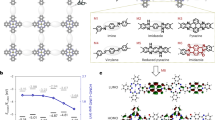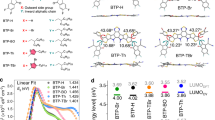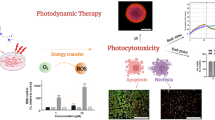Abstract
IN recent years Szent-Györgyi has directed attention to the possible importance of the electrical properties of organic molecules in biochemical catalysis1 and has given evidence for photoconductivity in gelatin2. An approach to the theory in trans-conjugated polyenes has been indicated by N. S. Bayliss3. Hoping to obtain a system suitable for quantitative investigation, I have examined the electrical conductivity of two phthalocyanines. These substances, described by Linstead and co-workers4, form a group of conjugated structures closely related to the biologically important porphyrins. They are particularly suitable for a research of this kind, because of their high degree of involatility and thermal stability. Their crystal structures are known from the work of J. M. Robertson5.
This is a preview of subscription content, access via your institution
Access options
Subscribe to this journal
Receive 51 print issues and online access
$199.00 per year
only $3.90 per issue
Buy this article
- Purchase on SpringerLink
- Instant access to full article PDF
Prices may be subject to local taxes which are calculated during checkout
Similar content being viewed by others
References
Szent-Györgyi, A., Nature, 148, 157 (1941); "Chemistry of Muscular Contraction" (Academic Press, New York, 1947).
Szent-Györgyi, A., Nature, 157, 875 (1946).
Bayliss, N. S., J. Chem. Phys., 16, 287 (1948).
Linstead, R. P., J. Chem. Soc., 1016 (1934) and later papers. See Ann. Rep. Chem. Soc., 34, 369 (1937).
Robertson, J. M., J. Chem. Soc., 615 (1935); 1195 (1936); 219 (1937); Ann. Rep. Chem. Soc., 37, 188 (1940).
Wilson, A. H., "Semiconductors and Metals" (Cambridge University Press, 1939).
Wilson, A. H., Proc. Roy. Soc., A, 133, 458 (1931); 134, 27 (1932). Mott, N. F., and Gurney, R. W., "Electronic Processes in Ionic Crystals", 156–158 (Oxford University Press. 1940).
Author information
Authors and Affiliations
Rights and permissions
About this article
Cite this article
ELEY, D. Phthalocyanines as Semiconductors. Nature 162, 819 (1948). https://doi.org/10.1038/162819a0
Issue date:
DOI: https://doi.org/10.1038/162819a0
This article is cited by
-
Biodegradation of bio-sourced and synthetic organic electronic materials towards green organic electronics
Nature Communications (2021)
-
Nickel phthalocyanine@graphene oxide/TiO2 as an efficient degradation catalyst of formic acid toward hydrogen production
Scientific Reports (2021)
-
A study of the optical band gap of zinc phthalocyanine nanoparticles using UV–Vis spectroscopy and DFT function
Applied Nanoscience (2017)
-
Measuring the electron affinity of organic solids: an indispensable new tool for organic electronics
Analytical and Bioanalytical Chemistry (2014)



